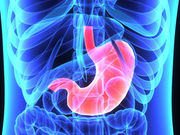Findings among obese patients with diabetes undergoing either gastric bypass, banding
MONDAY, Nov. 21, 2016 (HealthDay News) — Early metabolic differences following laparoscopic adjustable gastric banding (LAGB) and Roux-en-Y gastric bypass (RYGB) in obese individuals with type 2 diabetes mellitus (T2DM) disappear when weight loss reaches 20 percent, regardless of surgery type, according to a study published online Nov. 8 in Diabetes Care.
Marlena M. Holter, from Columbia University in New York City, and colleagues examined the effect of RYGB and LAGB on metabolic parameters in patients matched on small and large amounts of weight loss. Severely obese individuals with T2DM were tested for glucose metabolism, β-cell function, and insulin sensitivity after oral and intravenous glucose stimuli, before and one year after RYGB and LAGB, and at 10 and 20 percent weight loss after surgery.
The researchers found that RYGB resulted in greater glucagon-like peptide 1 release and incretin effect versus LAGB, at any level of weight loss. At 10 percent weight loss, RYGB decreased glucose levels (120 minutes and area under the curve for glucose) more than LAGB. However, after 20 percent equivalent weight loss, the improvement in glucose metabolism, the rate of diabetes remission and use of diabetes medications, insulin sensitivity, and β-cell function were similar after the two types of surgery.
“Although RYGB retained its unique effect on incretins, the superiority of the effect of RYGB over that of LAGB on glucose metabolism, which is apparent after 10 percent weight loss, was attenuated after larger weight loss,” the authors write.
Full Text (subscription or payment may be required)
Copyright © 2016 HealthDay. All rights reserved.








